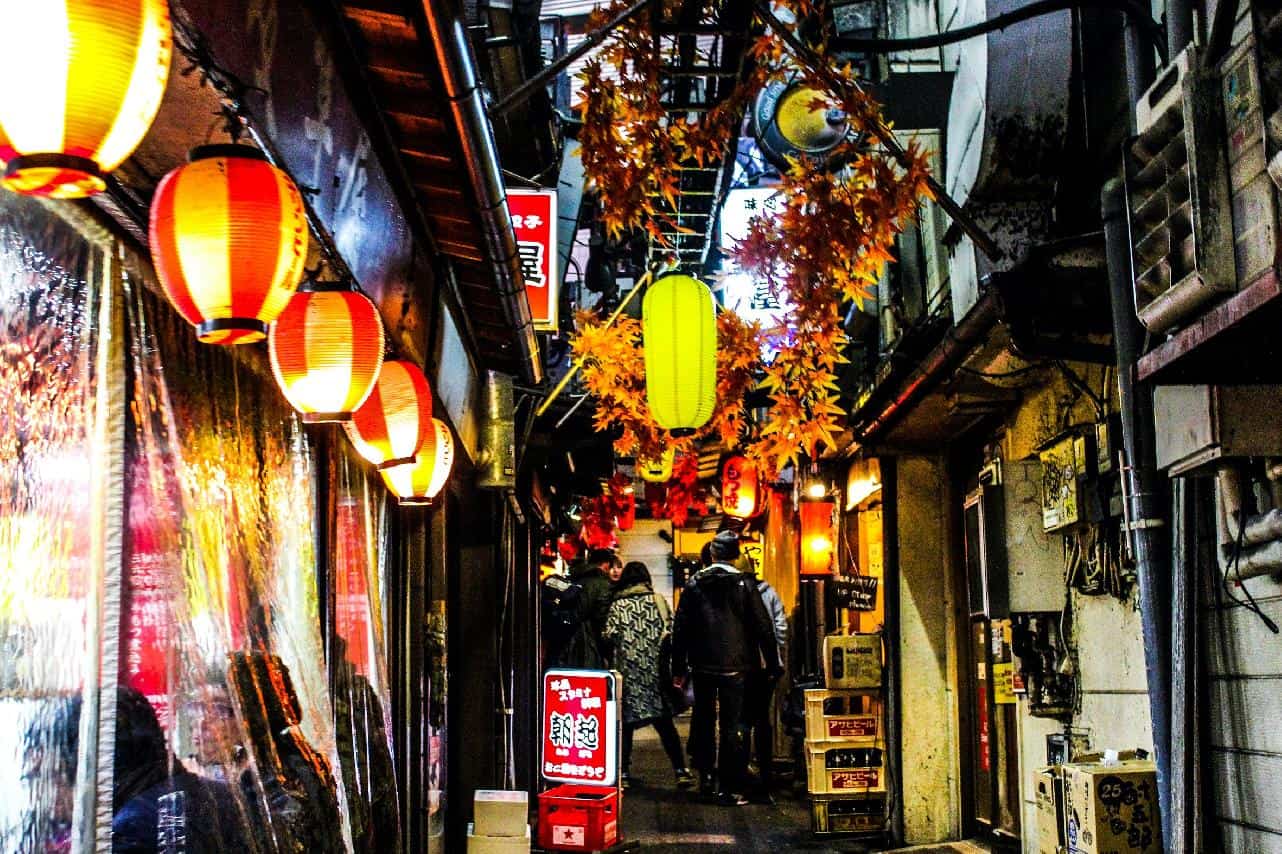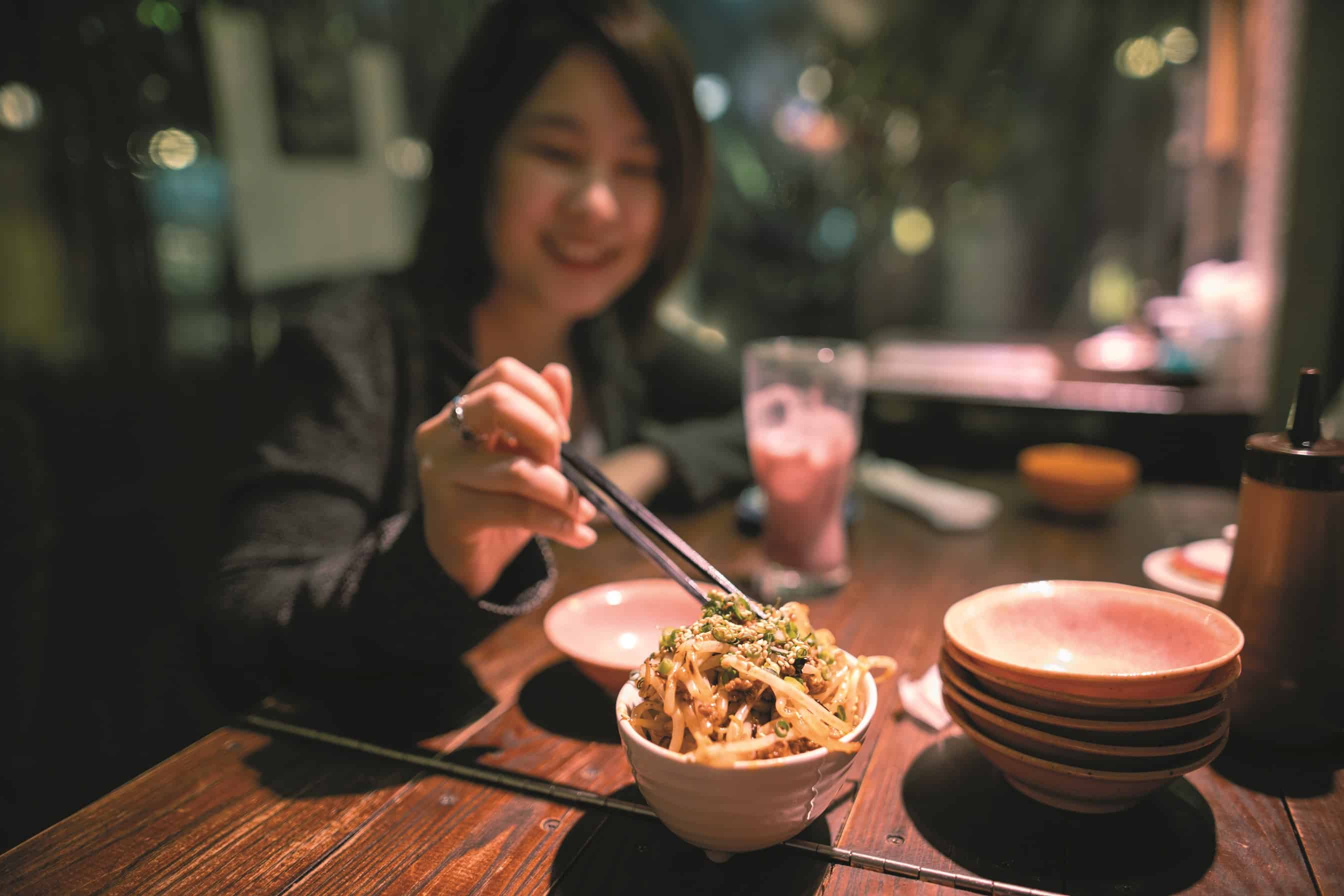A Canadian traveller walks into a Japanese izakaya bar. She can’t speak the language, nor read the menu, and the food is a complete mystery. As KATHERINE BRODSKY discovers, what might initially appear to be an isolating, intimidating experience often turns into convivial conversations with complete strangers that uniquely occur at the intersection of culture and curiosity.
IT’S GETTING DARK AND I HEAR MY STOMACH making demanding noises. I’ve been walking the cobblestone streets of Nara since arriving by train this morning and the only food my stomach has sampled today is deer cookies – which are not entirely meant to be eaten by humans. Admittedly, I did attempt to sneak a bite off a bun I was sharing with a deer but ended up being chased across the city’s famous Deer Park instead. People pointed and laughed, but the hunger remained.
I have a plan, with the perfect izakaya spot picked out in advance, though it turns out to no longer exist. Plan B, based on a recommendation, is full and waiting is not allowed.
Thanks to a quick Google search, I locate a wellreviewed izakaya restaurant with a Japanese name I can’t read, let alone pronounce (晴朗邸 勝手口 or Seiroutei Katteguchi, in English, as I later discover). Though, finding it isn’t entirely a simple task. It takes a solid half hour only to discover I have been standing right next to it the entire time.
 Emran Yousof
Emran Yousof
On the second floor of a nondescript plaza, I awkwardly walk into the tiny izakaya and I can’t help but feel like a foreign interloper. There are people gathered around the bar. I prepare for a language barrier. I sit shyly at the table as one of the owners, a petite woman, warmly greets me. She motions to one of the diners at the bar: “They can translate.”
For a moment, I’m relieved, believing that these patrons speak both English and Japanese. As it turns out, they don’t speak much more English than the owner. But they’ve got an app on their phone to help translate and they are willing to help.
I wait for the menu, but soon discover that there is no menu to be found here. Instead, all of the dishes are displayed in bowls that sit on the bar. I need only point at the items I’d like to consume. But I have no idea what any of it is. The patrons around the bar collectively pitch in with what English they can muster to explain what the dishes are. I order a few, still not exactly sure what I’m about to eat. One is a marinated medley of peppers and other vegetables, another resembles sardines. Another dish is completely unknown to me. What can go wrong?
Looking around, there’s a sense that I’m not in a pub or a restaurant. If it weren’t for the well-stocked bar and décor, I’d easily mistake this little mom-and-pop place for the interior of someone’s home where a group of old friends have gathered to enjoy the host’s cooking and conversation.
Tasting the food sends my taste buds spiralling. As we savour our dishes, the co-owner who so warmly greeted me sits down at the table and begins to ask me questions. Soon, a conversation is underway. It doesn’t take much English or Japanese to break the language barrier if both parties are willing and eager. And, we are. Yes, I’ve made it to the inside; to the inner circle.
By the end of the meal I’ve nicknamed our kind host and her husband, with whom she runs this izakaya, my “Japanese grandparents.” Acting faux offended, with a chuckle, she asks, “Grandparents? Not parents?” And in true grandparent form, they won’t let me leave without some parting gifts – namely candy and a few other Japanese sweets. They also insist on taking photos with me.
A pang of sadness falls over me as I say my goodbyes.

THOUGH NO TWO ARE ALIKE, izakayas are extremely popular in Japan. Many people live in tiny apartments, so socializing at home can be less common. At an izakaya, patrons can enjoy a variety of casual foods like Japanese tapas, fried dishes, gyoza (dumplings), yakisoba (fried noodles), yakitori (skewers) or even elevated dishes – the idea being that the food is meant to be an accompaniment with drinks and is often designed to be shared.
Once seated, you’ll be given an oshibori, which is a hot or cold towel to wipe your hands. Unlike the place I found myself in, most do have menus and with pictures to help you decide. Often, though not always, there’s a cover charge called otoshi where you’re given a small appetizer like edamame or a salad. Depending on the izakaya, customers either sit at the bar, at tables or on tatami mats and dine at low tables. There are even standing-only izakayas.
An izakaya is a communal experience, whether you come alone or with friends. And in a culture that can often be reserved and formal, at an izakaya, Japanese people find that they can really unwind and blow off steam after work.
 Recep Buyukguzel
Recep Buyukguzel
Izakaya origins go all the way back to the Edo period (between 1603 and 1868). The original idea was to have places where one could purchase a bottle of sake and sit down to drink it. Eventually, food also became part of the equation, along with additional types of alcohol. In the 70s and 80s, salarymen (office workers) were the dominant patrons, but these days izakayas are popular with just about everyone, of any age or gender. They can also vary in size, from postage stamp to several floors.
At an izakaya, the guest and chef or owner/host are in close proximity. Often, the food is even prepared right in front of them. They draw in regulars from the neighbourhood and it all contributes to building a sense of community and communal dining.
Frequenting an izakaya is part of a cultural tradition in Japan. It’s how colleagues bond after work and thanks to a drink or two (or three), they are able to let go of formality. The reserved facade falls, and instead, there’s lively chatter and laughter.

ON ANOTHER EVENING, half-asleep already, I’m convinced to grab some okonomiyaki (a delicious savoury pancake) at Hot Shot in Kyoto. The vibe here is considerably different than the family-run izakaya I visited in Nara – and there are menus in both Japanese and English. Everyone sits around the bar, chatting and laughing loudly – clearly more than a few drinks into the evening already.
The woman next to me warns me about the hot sauce I’m pouring all over my pancake. I brush her off; she’s severely underestimating my tolerance. And although initially I feel like I am interrupting a reunion between friends, it doesn’t take much time for everyone around the bar to become part of the conversation, yelling across the table.
I don’t speak a lick of Japanese, so I have to make do with Google Translate; or rather, Sensei Google, as it becomes known throughout the evening. We even bow down to it. The Japanese people around me enthusiastically throw in as much broken English as they know. Hand gestures help, too. We discuss animal cafés, Japanese and Hollywood actors, young Japanese pop stars and Bill Murray. Soon, I discover that it’s nearly 3 a.m. and we are still conversing. And then the whiskey sodas start arriving.
My new friends teach me a word in Japanese: yopparai. They point at a man at the bar who’s been drinking so long he’s barely able to string two words together – in either language. “Yopparai,” they repeat. It means "drunkard." Then they begin to point playfully to themselves, “Yopparai!” That’s right, they are all joyful drunkards, at least by night.
I’m sad to leave, but there’s a big day ahead tomorrow. No doubt, my friends will be drinking long after I drift off to slumberland. Many izakayas in Japan can stay open until 5 a.m., so there’s plenty of time to eat, drink and talk. The latter strikes me as being particularly unique to Japan.
When I walked in, I never expected to engage in conversation with the entire bar. But here I was, chatting long into the night like I’d just met some people at a friend’s house party.
In North America, I’m used to going to bars with friends. Sometimes, we’ll even do a happy hour. If we’re feeling particularly bold, we’ll talk to the bartender, but it’s unusual for all the patrons to start conversing amongst each other.
But at Japan’s izakayas, at least for an evening, I’m amongst local pals. It’s the closest to Cheers you’re going to get, even if we won’t remember each other’s names in the morning.

This article is presented in partnership with Collette, however the writer's travel experiences and opinions are all her own.
TRAVEL IS ALWAYS AN EYE-OPENING LEARNING EXPERIENCE.
You can meet new people, see different cultures and, of course, try new and delicious food. Where will your next experience take you? Collette offers more than 160 guided tours spanning all seven continents. From booking flights and hotel stays, to curating enriching, cultural experiences, even escorting you to and from the airport in a private luxury sedan, Collette takes care of all the details so all you have to do is enjoy your trip. Visit gocollette.com/en-ca or contact your travel advisor for further details.


